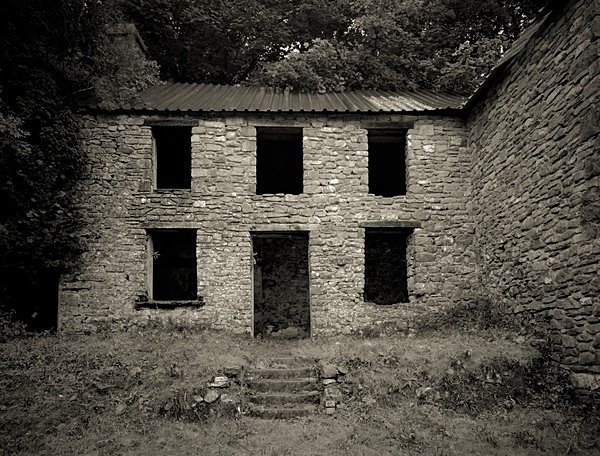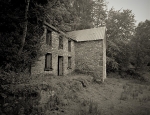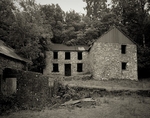PISTYLL NORTH, Abergorlech, Carmarthenshire 2020

Notes on PISTYLL NORTH, Abergorlech, Carmarthenshire 2020
Along a footpath/track and you soon come to the farmstead, large and spread out of Pistyll North. The house itself looks long ruinous, two mature tree trunks cut within the walls evidence the house has long been empty and ruinous. A new metal roof protects the solid walls. A large fireplace inside the extended section was in very poor condition – the extended section a somewhat odd looking intrusion of the main structure of the house, most likely a later addition(?). There were sheep inside when I visited, they left, I entered, I expected the floor to be foot deep in droppings and smelly but it was not, it was dry and a comfort from the rain outside. I wondered why the name of the house was half Welsh/half English. At home I searched on older maps and it seems the house has been called by the same spelling for at least a hundred years.
A long stone barn, partially collapsed at the front, stands facing the house at a slight angle. Other barns and outbuildings are scattered around. There’s a lot to see and because of the position of the buildings in relation with other buildings viewpoints/compositions are found easily. The site is for sale currently and it is truly exceptional. It needs a little insight but the general aura of the place is one of positively.
My visit was short, forty five minutes or so… exposures were quite long inside the house at around 6 minutes. There was a constant drizzle even if the forecast had been dry. There was no sound of traffic. No sound of farm machinery or even a dog barking somewhere someplace of. Even the birds seemed a little shy of the drizzle and judging by the birds in my garden, town birds aren’t much bothered by the rain and I doubt countryside ones aren’t either. The sheep however were bleating. They had seen me, followed me with their eyes as I walked along the track, and knew most likely and instantly that they did not know me. Yet still they bleated, neither in distress or in hope of food.
Along a footpath/track and you soon come to the farmstead, large and spread out of Pistyll North. The house itself looks long ruinous, two mature tree trunks cut within the walls evidence the house has long been empty and ruinous. A new metal roof protects the solid walls. A large fireplace inside the extended section was in very poor condition – the extended section a somewhat odd looking intrusion of the main structure of the house, most likely a later addition(?). There were sheep inside when I visited, they left, I entered, I expected the floor to be foot deep in droppings and smelly but it was not, it was dry and a comfort from the rain outside. I wondered why the name of the house was half Welsh/half English. At home I searched on older maps and it seems the house has been called by the same spelling for at least a hundred years.
A long stone barn, partially collapsed at the front, stands facing the house at a slight angle. Other barns and outbuildings are scattered around. There’s a lot to see and because of the position of the buildings in relation with other buildings viewpoints/compositions are found easily. The site is for sale currently and it is truly exceptional. It needs a little insight but the general aura of the place is one of positively.
My visit was short, forty five minutes or so… exposures were quite long inside the house at around 6 minutes. There was a constant drizzle even if the forecast had been dry. There was no sound of traffic. No sound of farm machinery or even a dog barking somewhere someplace of. Even the birds seemed a little shy of the drizzle and judging by the birds in my garden, town birds aren’t much bothered by the rain and I doubt countryside ones aren’t either. The sheep however were bleating. They had seen me, followed me with their eyes as I walked along the track, and knew most likely and instantly that they did not know me. Yet still they bleated, neither in distress or in hope of food.

|
